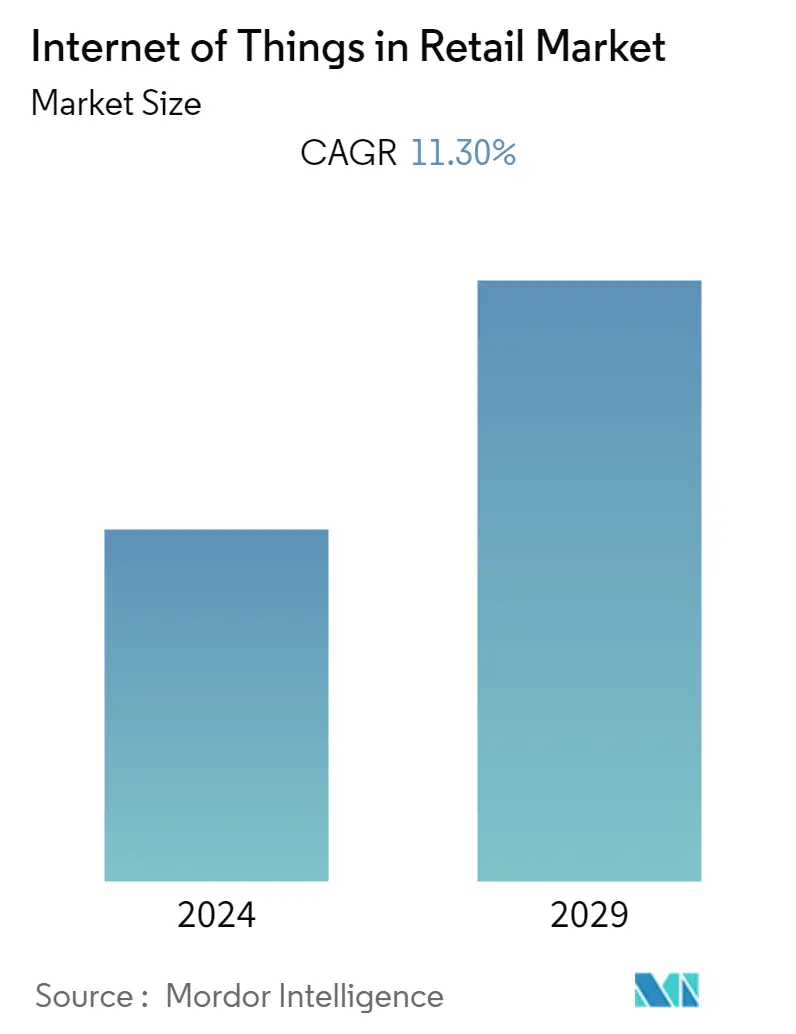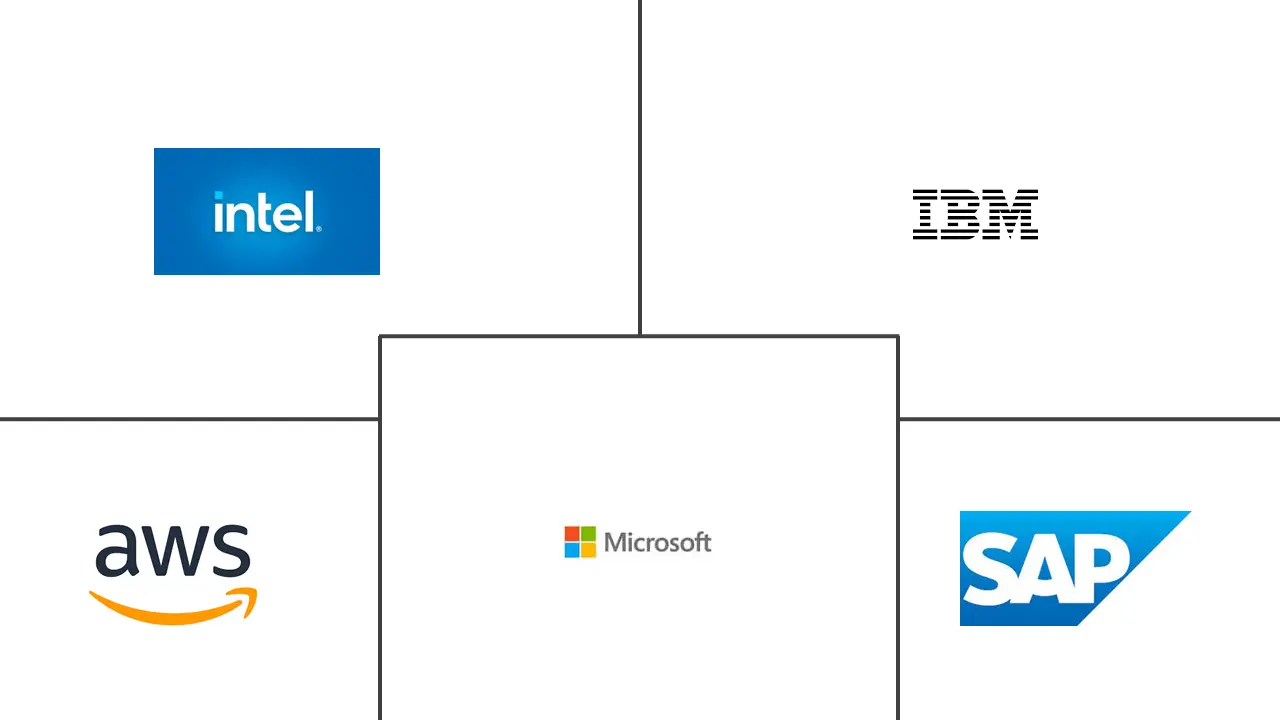Market Size of Internet of Things in Retail Industry

| Study Period | 2019 - 2029 |
| Base Year For Estimation | 2023 |
| CAGR | 11.30 % |
| Fastest Growing Market | Asia Pacific |
| Largest Market | North America |
| Market Concentration | Low |
Major Players
*Disclaimer: Major Players sorted in no particular order |
IoT in Retail Market Analysis
The global internet of things in the retail market is expected to witness a CAGR of 11.3% over the forecast period. The retail industry saw a significant impact from IoT in terms of boosting profitability and offering an enhanced omnichannel experience to retailers. With an existing network infrastructure likely to be used for 'connected things,' the investments and expenditures on analytics are projected to be high as companies strive to find new ways to analyze the significant volumes of smart device-generated data, augmenting the overall market's growth rate.
- IoT enables retailers to connect with both businesses and people. It allows retailers to gain insights into product performance and new ways of customer engagement with both new and existing customers. Several companies, like Kroger, Zara, Walmart, Tesco, etc., have launched smart devices to improve customer experience.
- Additionally, the e-commerce platform's use is rapidly increasing owing to the ease of shopping and smartphone penetration, which will likely boost the market. The increasing need for data analysis and analytics integration is expected to propel the utilization of the Internet of Things market over the forecast period. For instance, Amazon's first store in Seattle, the United States, is incorporated with a self-checkout service and mobile payment methods available on Android and iOS systems. The store is equipped with cameras, sensors, and RFID readers to identify shoppers and products and uses computer vision, deep learning algorithms, and the 'sensor fusion.'
- Also, with the advancement of artificial intelligence (AI) and augmented reality (AR) in retail establishments, the retail environment underwent a seismic shift. Retailers employ AI to identify the target market, comprehend the purchasing habits of past consumers, and provide customers with personalized product advertisements. For instance, in January this year, Google Cloud said it would launch four new artificial intelligence technologies aimed at retailers. The new technologies are mainly designed to aid retailers in transforming in-store shelf-checking processes and augment e-commerce operations, delivering more fluid and natural online shopping experiences. They also include a new "self-checking AI solution" that is primarily built on Vertex AI and leverages Google's extensive databases to provide retailers recognize "billions of products" and ensure that in-store shelves are well-stocked.
- However, with the rise in various security-related concerns and interoperability issues, the market's overall growth rate might get restrained throughout the forecast period.
- The pandemic significantly impacted IoT spending globally, especially in the retail sector. The merchants have postponed several new initiatives as their main priority during the economic crisis was maintaining corporate operations. As a result, IoT's retail market saw a revenue fall during the pandemic. However, it is anticipated that IoT use in retail will progressively rise after COVID-19. To eliminate human involvement and stop the coronavirus from spreading, retailers are already integrating AI technologies, cloud services, mobile payment systems, autonomous cleaning robots, and many others.
IoT in Retail Industry Segmentation
IoT helps retailers to gather data and produce insights without compromising data security. As a result, retailers can maintain the basic approaches to adopting in-store connectivity (such as enabling the IoT era at the endpoints).
The Internet of Things in the Retail Market is segmented by components (hardware, software, service (managed and professional)) and geography (North America, Europe, Asia-Pacific, Latin America, Middle East & Africa). The market sizes and forecasts are provided in value (USD million) for all the above segments.
| By Component | ||||
| Hardware | ||||
| Software | ||||
|
| Geography | |||||||
| |||||||
| |||||||
| |||||||
| Latin America | |||||||
| Middle East & Africa |
Internet of Things in Retail Market Size Summary
The Internet of Things (IoT) in the retail market is poised for substantial growth, driven by the need for enhanced profitability and improved omnichannel experiences. Retailers are increasingly leveraging IoT to connect with customers and businesses, gaining valuable insights into product performance and customer engagement. The integration of smart devices by major retailers like Kroger, Zara, and Walmart underscores the shift towards a more connected retail environment. The rise of e-commerce, fueled by smartphone penetration and the convenience of online shopping, further propels the market. Innovations such as Amazon's cashier-less stores and the use of AI and AR technologies are transforming the retail landscape, offering personalized shopping experiences and streamlining operations. However, challenges such as security concerns and interoperability issues may temper growth.
The market's expansion is also supported by advancements in NFC technology and mobile payment solutions, which offer new opportunities for customer interaction and engagement. Companies like Paytm and PhonePe are leading the charge in mobile wallet adoption, particularly in regions like India, where they are becoming preferred payment methods. The shift towards smart home environments and the deployment of IoT solutions for inventory management are enhancing operational efficiency and customer satisfaction. Retailers in the United States are embracing these technologies to compete with e-commerce giants like Amazon, using IoT to optimize supply chains and offer personalized experiences. Strategic partnerships and technological innovations, such as those by EY and KORE with Google Cloud, are further driving the adoption of IoT in retail, creating a more cohesive and integrated market landscape.
Internet of Things in Retail Market Size - Table of Contents
-
1. MARKET INSIGHTS
-
1.1 Market Overview
-
1.2 Industry Attractiveness - Porter's Five Forces Analysis
-
1.2.1 Bargaining Power of Suppliers
-
1.2.2 Bargaining Power of Buyers/Consumers
-
1.2.3 Threat of New Entrants
-
1.2.4 Threat of Substitute Products
-
1.2.5 Intensity of Competitive Rivalry
-
-
1.3 Industry Value Chain Analysis?
-
1.4 Technology Snapshot
-
-
2. MARKET SEGMENTATION
-
2.1 By Component
-
2.1.1 Hardware
-
2.1.2 Software
-
2.1.3 Service
-
2.1.3.1 Managed
-
2.1.3.2 Professional
-
-
-
2.2 Geography
-
2.2.1 North America
-
2.2.1.1 United States
-
2.2.1.2 Canada
-
-
2.2.2 Europe
-
2.2.2.1 United Kingdom
-
2.2.2.2 Germany
-
2.2.2.3 France
-
2.2.2.4 Italy
-
2.2.2.5 Rest of Europe
-
-
2.2.3 Asia-Pacific
-
2.2.3.1 China
-
2.2.3.2 India
-
2.2.3.3 Japan
-
2.2.3.4 Korea
-
2.2.3.5 Rest of Asia-Pacific
-
-
2.2.4 Latin America
-
2.2.5 Middle East & Africa
-
-
Internet of Things in Retail Market Size FAQs
What is the current Internet of Things in Retail Market size?
The Internet of Things in Retail Market is projected to register a CAGR of 11.30% during the forecast period (2024-2029)
Who are the key players in Internet of Things in Retail Market?
Amazon Web Services Inc., IBM Corporation, Intel Corporation, Microsoft Corporation and SAP SE are the major companies operating in the Internet of Things in Retail Market.

